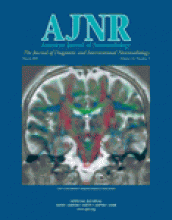Abstract
BACKGROUND AND PURPOSE: Identification of the intracranial collaterals assists in identifying patients with severe occlusive disease of the internal carotid arteries who are at lower risk of transient ischemic attacks (TIAs) and stroke. We investigated the usefulness of MR angiography in identifying functional collaterals of the circle of Willis.
METHODS: MR angiography of the circle of Willis was performed in 50 healthy volunteers. Visibility was used as the criterion to define the intracranial collaterals as being functional. Two observers independently assessed the MR angiograms. Results were compared with those of transcranial color duplex sonography (TCCD), and results of carotid compression tests were the standard of reference for the identification of functional intracranial collaterals.
RESULTS: With MR angiograms, reviewer 1 achieved a sensitivity of 85%, a specificity of 81%, a positive predictive value of 95%, and a negative predictive value of 55%. Reviewer 2 achieved a sensitivity of 87%, a specificity of 67%, a positive predictive value of 92%, and a negative predictive value of 53%. Interobserver agreement on MR angiograms was moderate (κ = 0.57, 95% confidence interval: 0.42, 0.72).
CONCLUSION: Visible collaterals of the circle of Willis on MR angiograms are able to supply collateral flow in the presence of carotid artery obstruction. However, the low negative predictive value of MR angiography indicates that, if collaterals are not visible, supplementary TCCD investigation is required.
- Copyright © American Society of Neuroradiology












